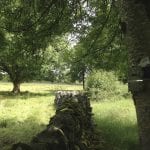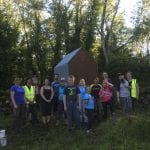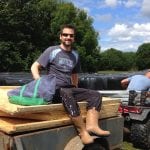Killian Forde
We’ve known Kilian and his family since 1998 when the Trust bought a derelict cottage near his farm that was being used by approximately 30 lesser horseshoe bats in summer. Since then Kilian has assisted us in a variety of ways, all of which have helped us in our work to conserve this colony, now numbering over 150 bats. Of all the bat species found in Ireland, the lesser horseshoe bat is the one most dependent on access to old buildings on farms.
From the outset Kilian and his family took an interest in our work. When his children were small they joined us to watch the bats as they emerged from the cottage at dusk. On one occasion, about ten years after we had restored the building for the bats, a small wooden gate leading to it disintegrated following a storm. Kilian rang to let us know and before we could view the damage and organise a replacement, he had made and fitted a new gate.
In addition to providing day roosting sites for the lesser horseshoe bat, we try to improve the habitats in the vicinity of the roosts where the bats hunt. One way to do this is to erect timber structures along commuting routes used by the bats so they can rest up between foraging periods and thus safe energy. We call these structures ‘Night Roosts’ and we wanted to erect one of these near Fiddaun Cottage, but the Trust doesn’t own any land. Kilian not only offered us a spot on his farm to locate one, but he also allowed us to store the materials on his farm until we had arranged a day for volunteers to help us assemble it, he transported the heavy timber panels on site on that day and he later erected fencing to protect the roost from his curious cattle. The night roost was used within weeks by lesser horseshoe bats and also by Leisler’s and soprano pipistrelles. When Storm Ophelia nudged the roost onto a stone wall, Kilian rang to let us know, and then set it back in place for us.
Lesser horseshoe bats are not able to fly across open areas and rely on linear features, such as stone walls and hedgerows, to fly between their day and night roosts, their foraging grounds and their hibernation sites. We’ve been able to undertake a study of these at Fiddaun thanks to Kilian because we’ve been able to place passive bat detectors on his farm that automatically record bat activity from dusk to dawn. This type of study is time consuming and only possible because we have the help of a team of volunteers, whom Kilian has welcomed onto his land.
The maternity colony of horseshoe bats at Fiddaun has benefitted from the assistance that Kilian has provided to us for over twenty years. When we thank him, he says ‘it’s nothing’. But without the support of farmers like Kilian, conserving this species would be an even greater challenge.
Nominator: Kate McAney, Head of Conservation Development, Vincent Wildlife Trust



